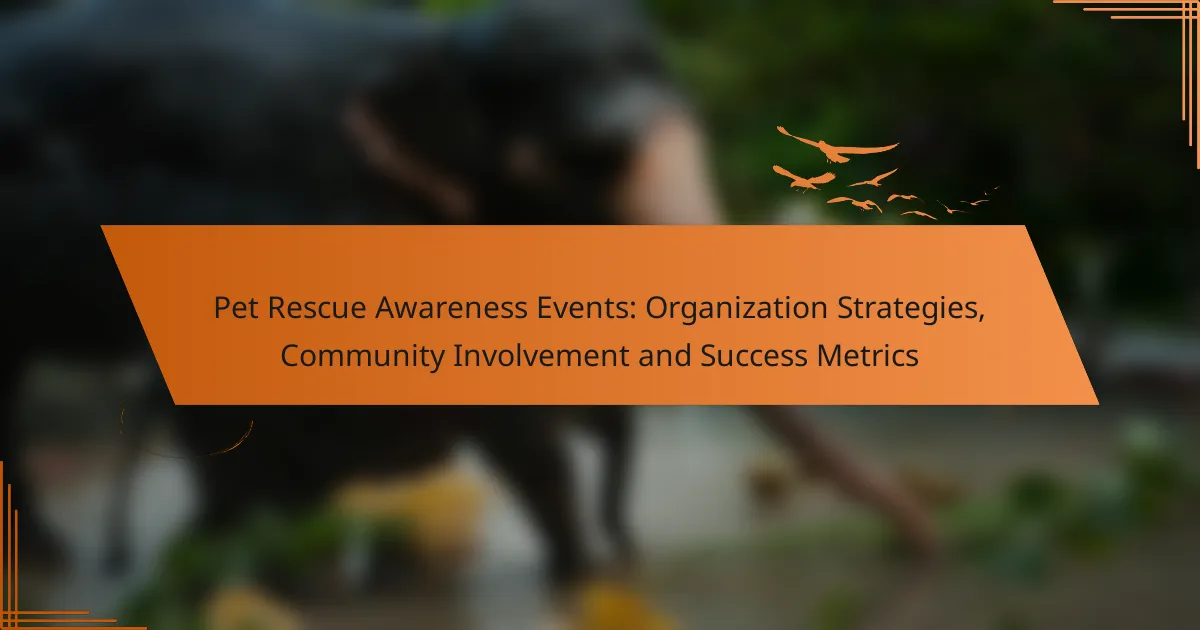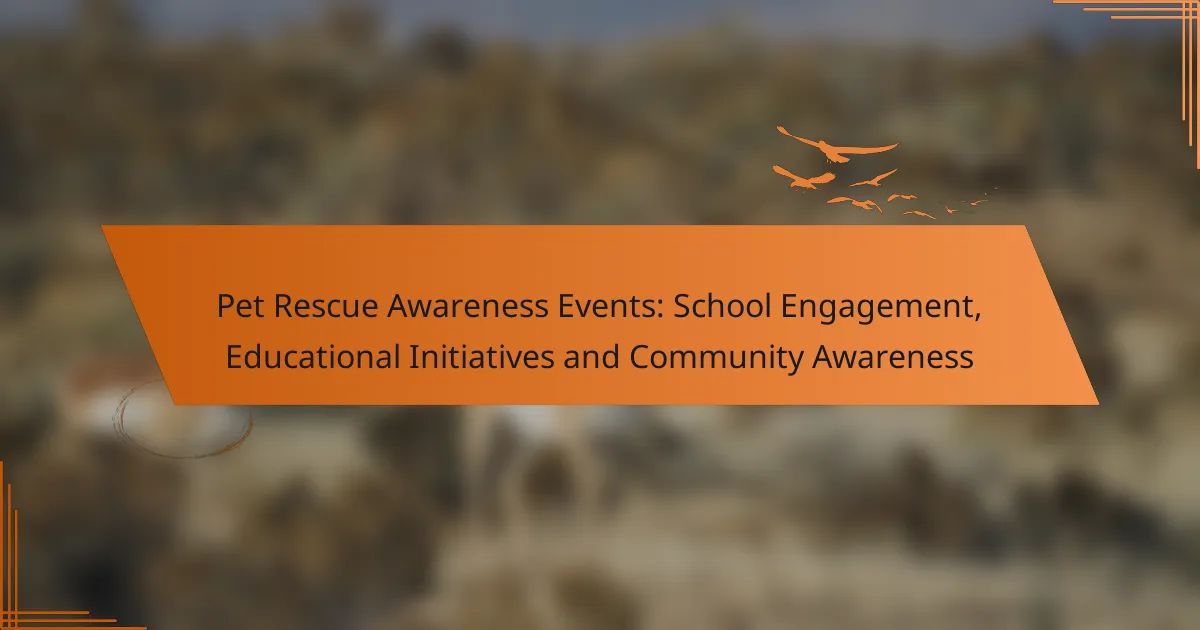Pet rescue awareness events play a crucial role in promoting animal welfare and community engagement. By implementing clear objectives and strategic planning, organizations can effectively mobilize resources and foster community involvement. Success can be measured through various metrics, ensuring that these events not only raise awareness but also create lasting positive impacts.
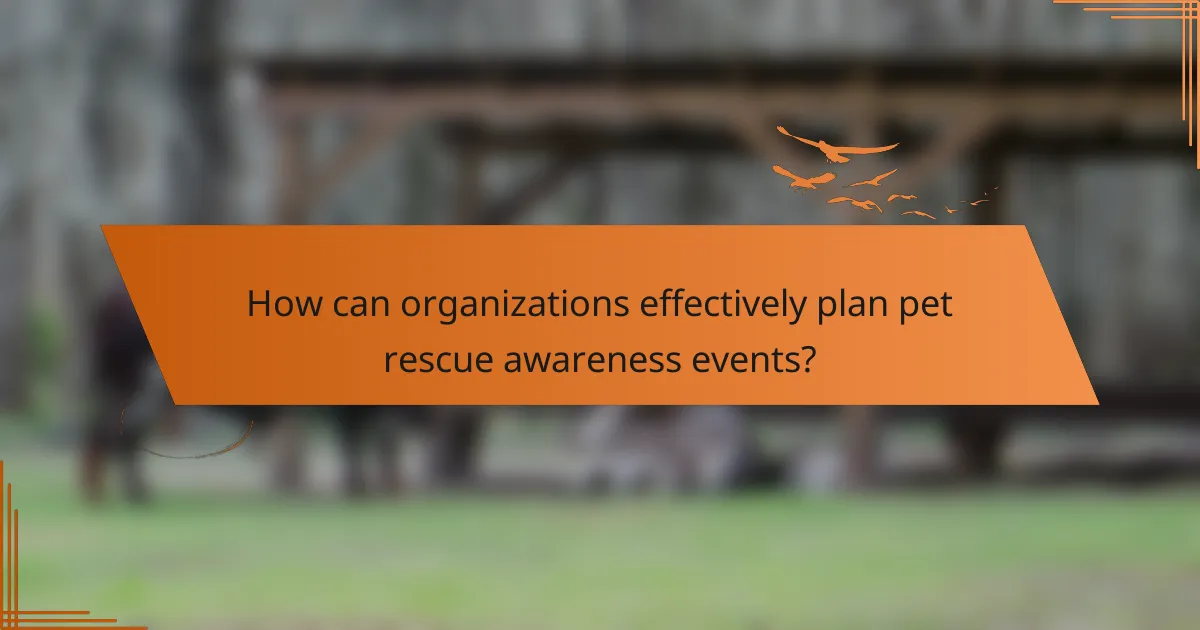
How can organizations effectively plan pet rescue awareness events?
Organizations can effectively plan pet rescue awareness events by focusing on clear objectives, engaging the community, and ensuring thorough preparation. Key strategies include creating a detailed event plan, managing budgets wisely, and leveraging partnerships to enhance outreach.
Event planning checklist
An event planning checklist is essential for organizing a successful pet rescue awareness event. Start by defining the event’s purpose, target audience, and key activities. Include tasks such as securing permits, arranging for speakers, and coordinating volunteers.
Consider adding deadlines for each task to keep the planning process on track. A checklist can also help ensure that all necessary supplies, such as promotional materials and pet care items, are available on the event day.
Budgeting strategies for events
Effective budgeting is crucial for the success of pet rescue awareness events. Begin by estimating costs for venue rental, permits, promotional materials, and refreshments. Aim to allocate funds for unexpected expenses, typically around 10-15% of the total budget.
Seek sponsorships from local businesses or donations of goods and services to reduce costs. Additionally, consider charging a small entry fee or offering merchandise to generate revenue while promoting the cause.
Partnership opportunities with local businesses
Partnering with local businesses can significantly enhance the reach and impact of pet rescue awareness events. Look for pet supply stores, veterinary clinics, and grooming salons that may be interested in collaborating. These businesses can provide sponsorships, donate items for raffles, or offer discounts to attendees.
Establishing these partnerships not only helps with funding but also fosters community engagement, as local businesses often have loyal customer bases that can be tapped into for event promotion.
Utilizing social media for promotion
Social media is a powerful tool for promoting pet rescue awareness events. Create event pages on platforms like Facebook and Instagram to share details, updates, and engaging content. Use eye-catching visuals and stories to attract attention and encourage shares.
Consider running targeted ads to reach specific demographics interested in pet adoption and welfare. Engaging with followers through polls, contests, and live Q&A sessions can also boost interest and participation.
Choosing the right venue
Selecting the right venue is vital for the success of pet rescue awareness events. Consider locations that are easily accessible and have adequate space for activities, vendors, and attendees. Parks, community centers, or pet-friendly venues can be excellent choices.
Ensure the venue has necessary amenities such as restrooms, parking, and shelter in case of inclement weather. Additionally, check for any local regulations regarding pet presence and noise levels to avoid potential issues during the event.
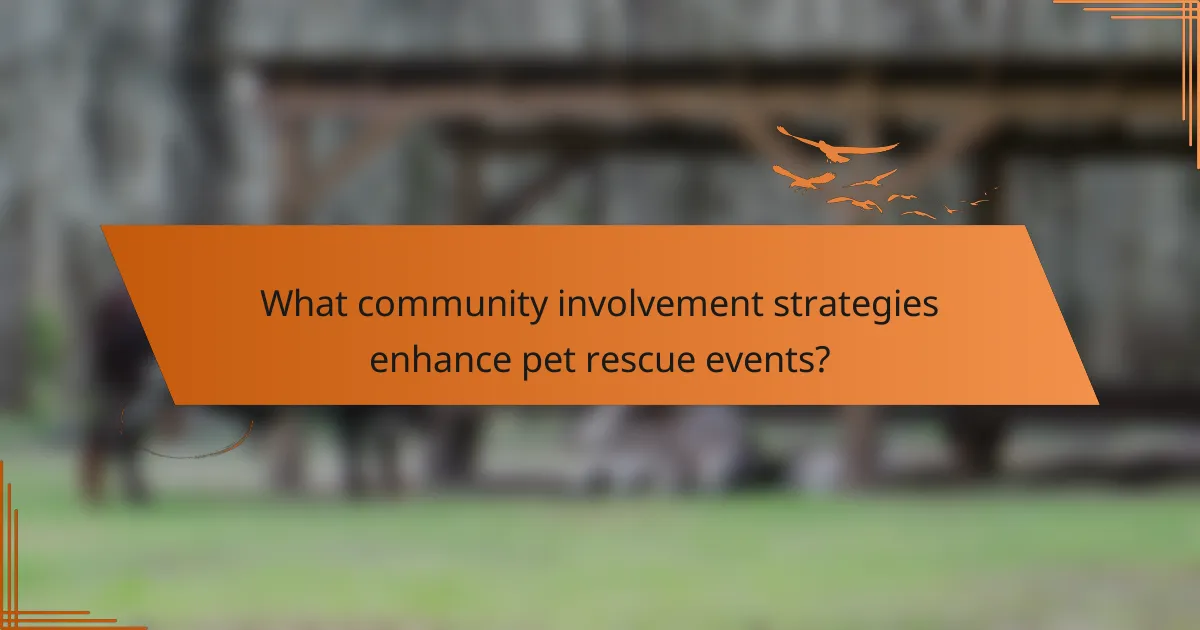
What community involvement strategies enhance pet rescue events?
Effective community involvement strategies for pet rescue events include engaging local volunteers, partnering with schools, collaborating with animal shelters, and creating sponsorship opportunities for businesses. These approaches foster a sense of community ownership and increase participation, ultimately leading to more successful events.
Volunteer recruitment methods
Recruiting volunteers for pet rescue events can be achieved through social media campaigns, local community boards, and partnerships with universities. Highlighting the benefits of volunteering, such as gaining experience in animal care and contributing to a good cause, can attract a diverse group of participants.
Consider hosting an orientation session to inform potential volunteers about their roles and responsibilities. This can help set expectations and ensure that volunteers feel prepared and motivated to contribute effectively.
Engaging local schools and youth groups
Involving local schools and youth groups in pet rescue events can foster a sense of responsibility and compassion among young people. Organizing educational workshops or service projects related to animal welfare can encourage students to participate actively.
Offering community service hours or recognition for participation can further incentivize involvement. Schools may also host fundraising events, such as bake sales or pet-themed activities, to support local rescue efforts.
Collaborating with animal shelters
Partnering with animal shelters can enhance pet rescue events by providing resources, expertise, and visibility. Shelters can assist in promoting the event through their networks and may offer volunteers or adoptable pets for showcasing.
Establishing a mutual support agreement can streamline logistics and ensure that both the event and the shelter benefit from the collaboration. This partnership can also help raise awareness about the shelter’s ongoing needs and initiatives.
Creating sponsorship packages for businesses
Developing sponsorship packages for local businesses can provide essential funding and resources for pet rescue events. These packages should outline the benefits for sponsors, such as brand exposure, community goodwill, and potential tax deductions.
Consider offering tiered sponsorship levels with varying benefits, such as logo placement on promotional materials or recognition during the event. This approach can attract a wider range of businesses, from small local shops to larger corporations, enhancing the event’s overall success.
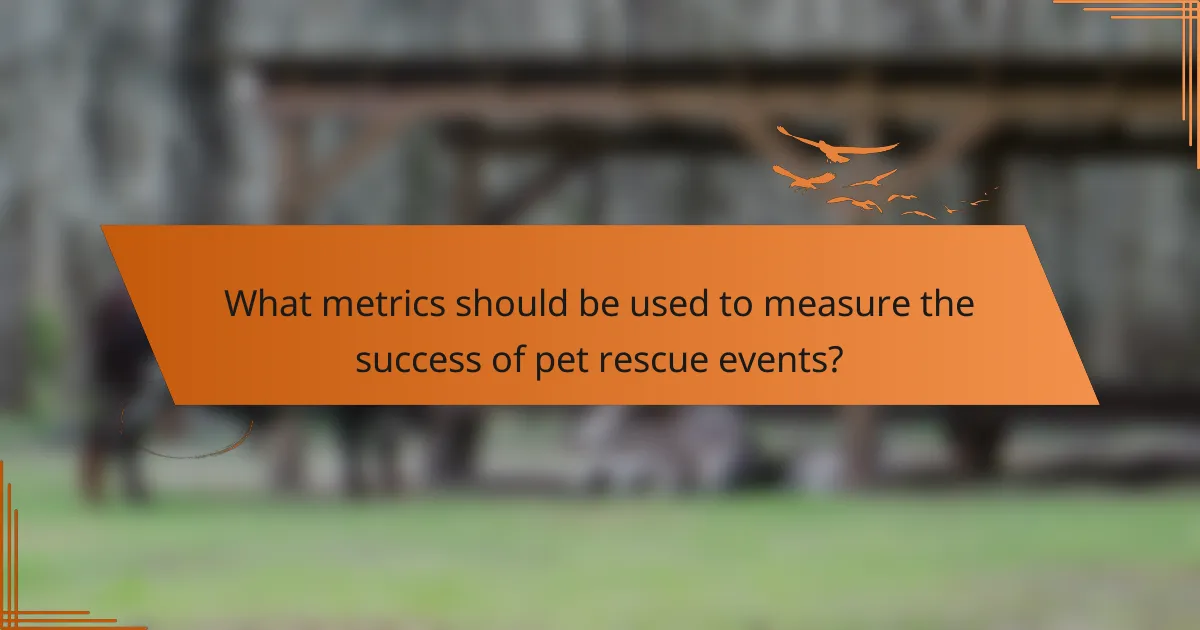
What metrics should be used to measure the success of pet rescue events?
To effectively measure the success of pet rescue events, organizations should focus on attendance rates, funds raised, social media engagement, and feedback from participants. These metrics provide a comprehensive view of the event’s impact and areas for improvement.
Attendance and participation rates
Attendance and participation rates are critical indicators of an event’s reach and community interest. Tracking the number of attendees compared to previous events can help gauge growth and engagement. Aim for a steady increase in attendance over time, which can signify effective outreach and marketing efforts.
Consider offering incentives for early registration or group participation to boost numbers. Additionally, tracking demographic information can help tailor future events to better meet community needs.
Funds raised for rescue organizations
The amount of money raised during a pet rescue event is a primary measure of its success. This includes ticket sales, donations, and sponsorships. Set clear financial goals before the event and track progress in real-time to motivate participants and volunteers.
To maximize funds raised, consider incorporating multiple fundraising strategies such as auctions, merchandise sales, or donation matching from local businesses. Transparency about how funds will be used can also encourage more generous contributions.
Social media engagement statistics
Social media engagement statistics provide insight into how well the event resonated with the community online. Metrics such as likes, shares, comments, and overall reach can indicate the effectiveness of promotional efforts. Aim to create shareable content that encourages attendees to post about their experiences.
Utilizing specific hashtags related to the event can help track engagement and create a sense of community among participants. Regularly monitoring these metrics can inform future marketing strategies and enhance online presence.
Post-event surveys for feedback
Post-event surveys are essential for gathering feedback from participants, which can highlight strengths and areas for improvement. Distributing surveys shortly after the event ensures that experiences are fresh in attendees’ minds. Focus on questions that assess overall satisfaction, suggestions for future events, and specific aspects like organization and activities.
Consider offering a small incentive for completing the survey to increase response rates. Analyzing this feedback can provide valuable insights that inform planning for future pet rescue events, ensuring they better meet the community’s expectations and needs.

How can e-commerce platforms support pet rescue awareness events?
E-commerce platforms can significantly enhance pet rescue awareness events by providing tools for fundraising, promoting merchandise, and facilitating donations. These platforms allow organizations to reach wider audiences and generate more support through online sales and marketing strategies.
Donation options through online sales
E-commerce platforms can integrate donation options directly into the checkout process, allowing customers to contribute to pet rescue organizations while making purchases. This can be a fixed amount or a percentage of the sale, making it easy for customers to support a cause they care about.
Consider offering a “round-up” feature where customers can round their total to the nearest dollar, with the difference going to the rescue organization. This small change can lead to significant contributions over time, especially if promoted effectively.
Merchandise sales for fundraising
Selling branded merchandise is a powerful way to raise funds for pet rescue events. Items like t-shirts, mugs, and pet accessories can be designed to promote the cause and create a sense of community among supporters. Ensure that the merchandise reflects the mission of the rescue organization to resonate with buyers.
When setting prices, consider production costs and the target audience’s willingness to pay. Aim for a balance that maximizes profit while remaining affordable. Offering limited-time items can create urgency and boost sales.
Promoting events through email marketing
Email marketing is an effective tool for promoting pet rescue awareness events. By building a mailing list of supporters, organizations can send targeted campaigns that inform recipients about upcoming events, fundraising goals, and ways to get involved. Personalizing emails can increase engagement and response rates.
Include clear calls to action in your emails, such as links to purchase merchandise or donate. Segment your audience based on past interactions to tailor messages that resonate with different groups, enhancing the likelihood of participation and support.
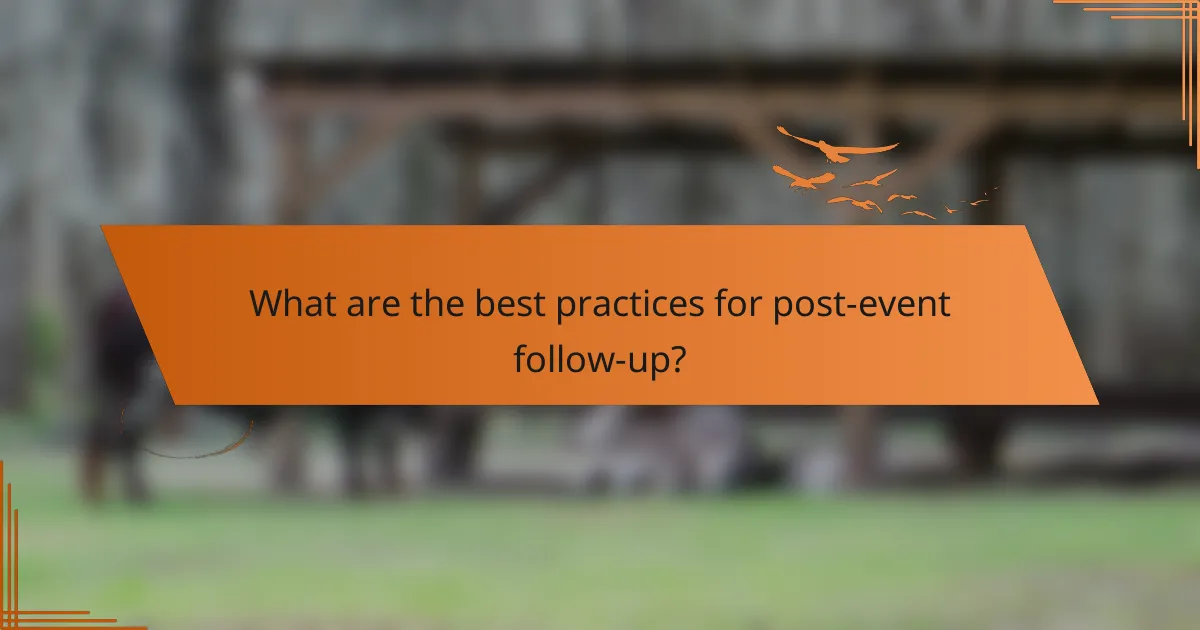
What are the best practices for post-event follow-up?
Effective post-event follow-up is crucial for maintaining relationships and maximizing the impact of pet rescue awareness events. Best practices include timely communication, expressing gratitude, and gathering feedback to improve future initiatives.
Thanking volunteers and sponsors
Expressing gratitude to volunteers and sponsors is essential for fostering goodwill and encouraging future participation. A personalized thank-you note or email can go a long way in showing appreciation for their contributions. Consider hosting a small appreciation event or providing certificates of recognition to highlight their support.
In addition to direct communication, publicly acknowledging volunteers and sponsors through social media or your organization’s website can enhance their visibility and strengthen your partnership. This not only shows appreciation but also encourages others to get involved in future events.
